Everything You Always Wondered About Human Origins
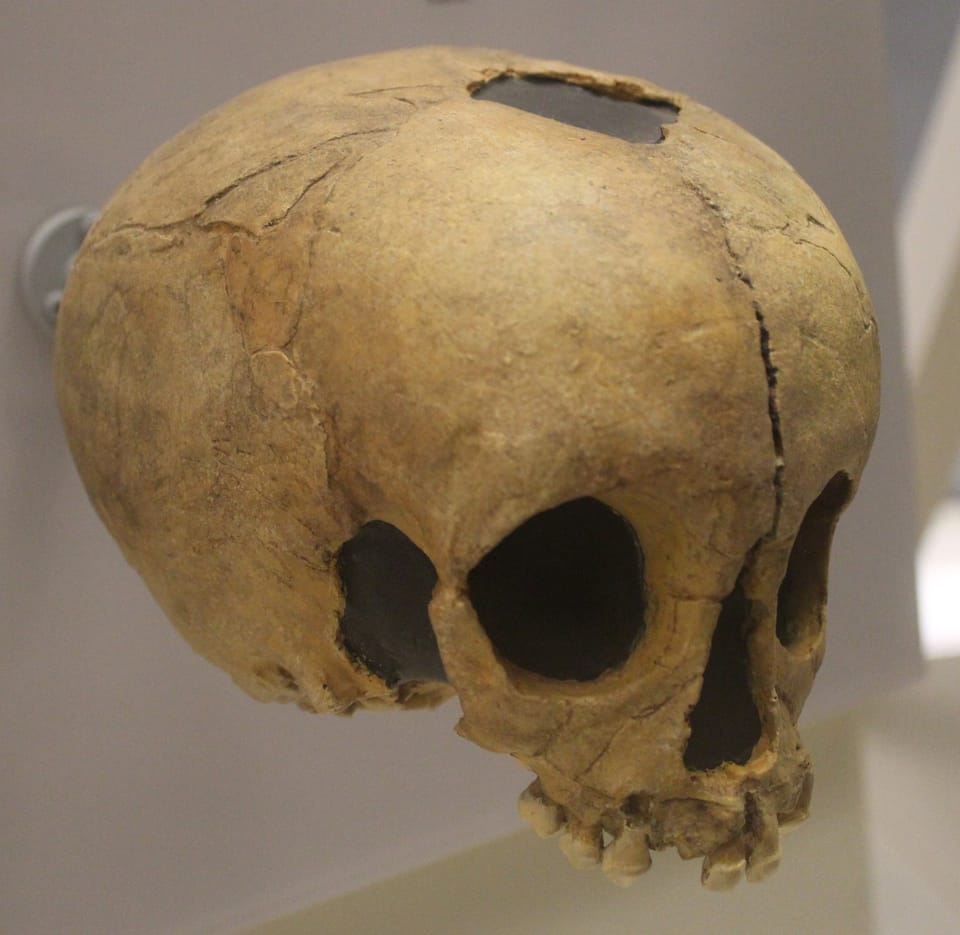
A Primer for the Curious
This high-level guide explores how humans came to be—not through myth or metaphor, but through fossils, DNA, and an occasionally absurd evolutionary path. If you're curious about where we came from, what makes us different (or not so different) from our cousins, and how scientists actually figure this stuff out, you're in the right place.
We’ll begin by tracing the evolutionary path from early primates through the great ape lineage, leading up to the emergence of hominins. From there, we’ll follow the fossil trail from bipedal ancestors to modern humans, evaluate how much evidence we actually have, and finish by unpacking the terminology and classification systems that help scientists make sense of it all.
This essay is divided into five parts so you can go deep or just dip in where you like:
- Part 1 traces our story from early primates to the split with chimpanzees.
- Part 2 picks up with upright-walking hominins and ends with us—Homo sapiens.
- Part 3 asks how many fossils we've found, how many individuals they represent, and how widely scattered the finds are.
- Part 4 breaks down essential evolutionary terms and taxonomy.
- Part 5 offers links and resources to keep exploring.
Whether you're here for the science, the strangeness, or just to answer that nagging question about where hobbit humans fit in, this journey has something for you.
Part 1: The Road to Humanity – Laying the Groundwork
The story of human evolution is not a tale of constant progress, but one of twists, turns, and a whole lot of dead ends. Forget the outdated image of a stooped ape slowly straightening into a laptop-using Homo sapiens. The real picture is more like a tangled thicket of evolutionary experiments, most of which didn’t go anywhere. Still, we can trace a reasonably coherent line of ancestry through the fossil record—if we squint and don’t mind a few scientific debates along the way.
Our journey begins not with humans or even apes, but with early primates. Around 55 million years ago, the first primates appeared—small, tree-dwelling creatures with grasping hands and forward-facing eyes. Fast forward to about 33–29 million years ago, and we meet Aegyptopithecus zeuxis, an early ape that lived in what is now Egypt. This creature likely resembles the common ancestor of both modern monkeys and apes. From there, evolution gave us Proconsul africanus around 23–14 million years ago, a more advanced ape that walked on the tops of branches and lacked a tail—key traits distinguishing apes from monkeys.
Somewhere around 10 million years ago, gorillas split off from the line that would eventually lead to us. Not long after—perhaps 6.5 to 7 million years ago—our ancestors parted ways with the chimpanzee line. This marks the crucial human–chimpanzee split. The species that comes next, Sahelanthropus tchadensis, dated to around 7–6 million years ago, may be one of the earliest hominins (human relatives more closely related to us than to chimps).
That brings us to the real meat of the matter: the fossils themselves. Let’s walk through the milestones that define our tangled evolutionary journey.
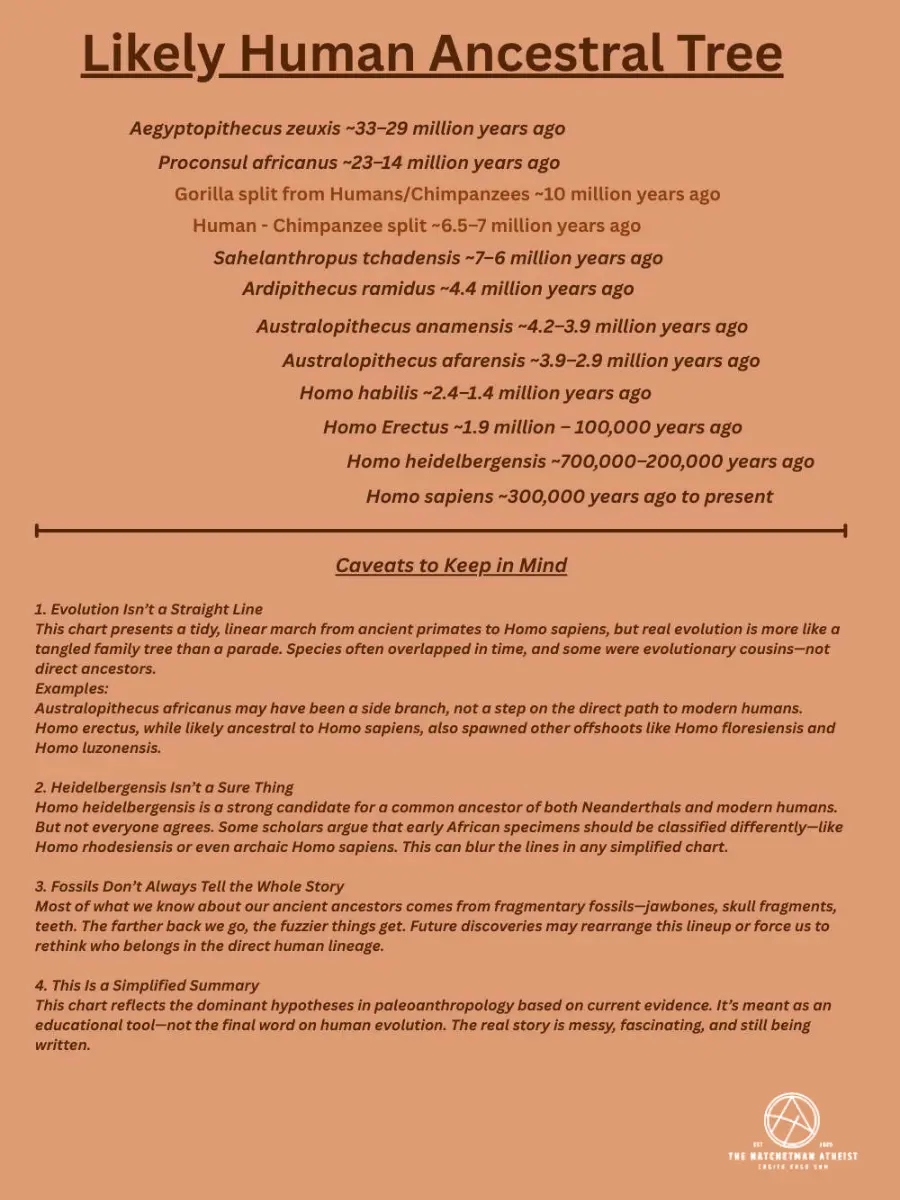
Part 2: The Tangled Tree – Walking Upright and Thinking Big
After the split from chimps, the fossil trail continues with Ardipithecus ramidus, dated to around 4.4 million years ago. Ardi walked upright, but still had adaptations for climbing. Next comes Australopithecus anamensis (4.2–3.9 million years ago), followed by the famous Australopithecus afarensis (3.9–2.9 million years ago), whose best-known representative is “Lucy.” These species had small brains but walked on two legs, a key hallmark of the hominin lineage.
If you’ve ever stood next to a cast of Lucy’s bones in a museum, you know the weird sense of recognition it sparks. She’s not quite us—but she’s not not us, either.
Around 2.4–1.4 million years ago, we meet Homo habilis, the so-called “handy man” who shows the first substantial leap in brain size and tool use. Homo erectus, appearing around 1.9 million years ago and surviving until about 100,000 years ago, represents a major milestone. This species had modern human-like body proportions and spread far beyond Africa, reaching Asia and possibly Europe.
Now things get really tangled. Homo heidelbergensis, appearing between 700,000 and 200,000 years ago, is considered by many to be the common ancestor of both Neanderthals (Homo neanderthalensis) and modern humans (Homo sapiens), as well as the Denisovans—an elusive sister group to Neanderthals, identified through DNA from Siberian fossils. Whether H. heidelbergensis is a valid species or a catch-all for a bunch of transitional forms is still debated.
Note: Denisovans have not been formally named with a species designation (e.g., Homo denisova) because they’re known primarily from DNA and fragmentary fossils. Still, most researchers treat them as a sister group to Neanderthals within the genus Homo.
As an aside, don’t forget Homo floresiensis (the “hobbits”) and Homo luzonensis, two small-bodied hominins who may have branched off from early H. erectus migrants. These oddballs remind us that human evolution wasn’t a steady march of progress, but a wild experiment with many outcomes.
Finally, Homo sapiens appears around 300,000 years ago in Africa and eventually becomes the last hominin standing.
But storytelling isn’t science—at least not without the bones to back it up. So how much hard evidence do we actually have?
🧬 More from the Human Evolution Series
- The Giraffe’s Ridiculous Nerve: A Case for Evolution
- How the Eye Evolved: A Step-by-Step Guide for Skeptics
- Creation 'Science' and the Gospel According to AiG
- Kitzmiller v. Dover: Behe, Biology, and the Tower of Denial
- Part 2: Pandas, Proponentsists, and the Find-and-Replace Fail
- Part 3: The Scientists Speak, the Designers Scatter
Part 3: The Fossil Trail – How Much Evidence Do We Actually Have?
Here’s a breakdown of the species listed so far, including rough estimates of how many distinct individuals and fossil sites are currently known. These numbers are approximate and will change as new discoveries are made:
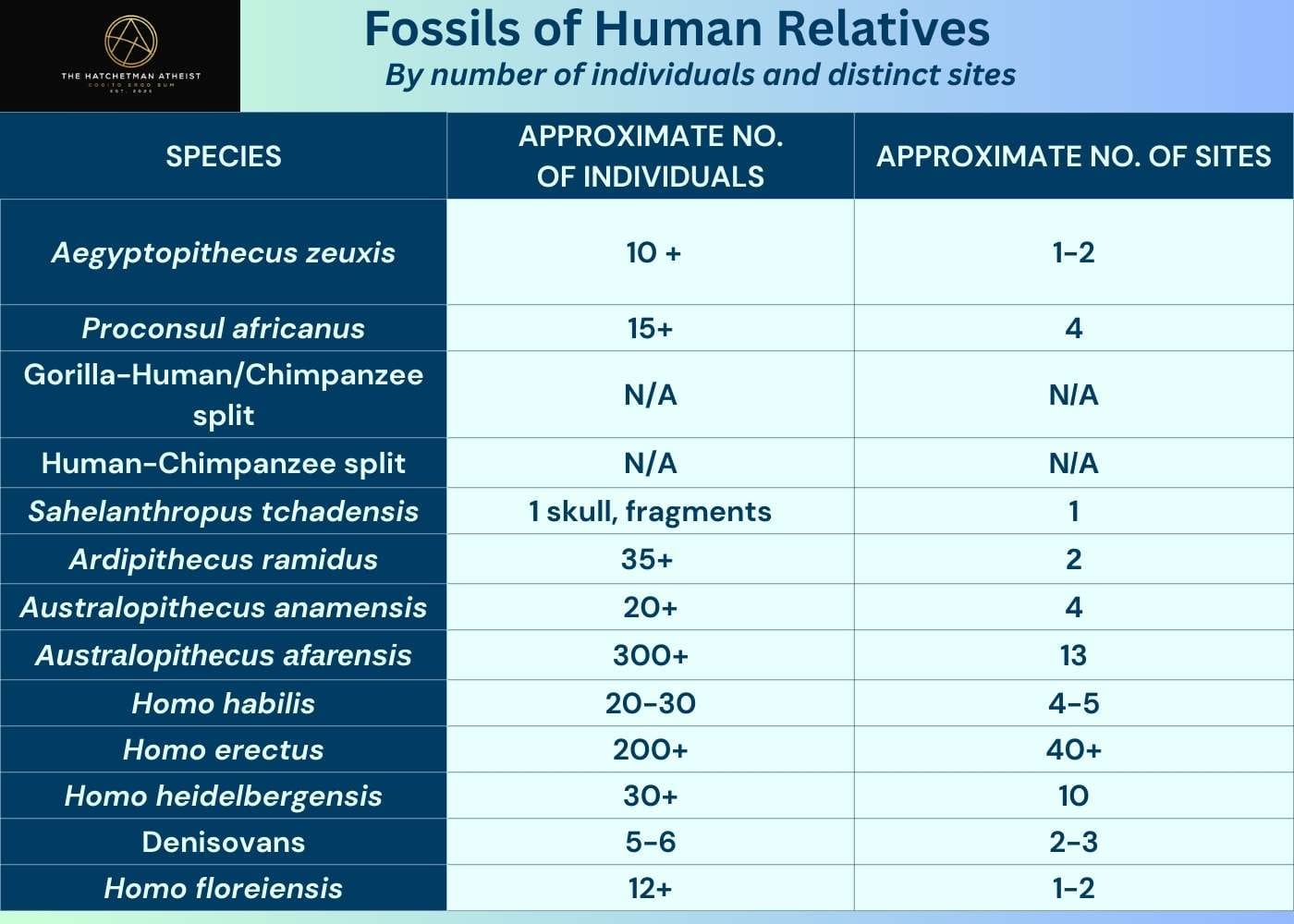
This data shows just how rare early fossils are. Most species are known from fragments—a jawbone here, a femur there. The fossil record plays favorites. It preserves best in dry caves and lucky sediment beds—and in countries where scientists have had the money and permission to dig.
And yet, despite the spotty evidence, a remarkably consistent story emerges: we are just one branch on a wide and tangled family tree. If that doesn’t make you pause the next time you look in the mirror, maybe try again with better lighting.
Part 4: A (Very) Brief Primer on Framework and Terminology
Paleoanthropology – The scientific study of human evolution, combining paleontology and physical anthropology to understand early human fossils, behaviors, and environments.
What Can Fossils Tell Us?
Fossils give us clues about how our ancestors moved, what they ate, and even what kind of environments they lived in. Researchers look at bones, teeth, skull shapes, and even microscopic wear patterns to reconstruct ancient lifestyles. The combination of skeletal structure and, in some cases, ancient DNA, helps us map out our evolutionary tree.
Fossils are not bones: To be clear, fossils are not the original bones themselves. Over time, the organic material is replaced with minerals, turning the bone into stone. So when we talk about fossils, we're talking about impressions or mineral copies of the original bones.
Taxonomy and Classification
Bipedalism vs. Quadrupedalism
You’ll also see the word “morphology” used a lot. This just means body structure. When we say a species shows “bipedal morphology,” we’re saying their bones are shaped for walking upright, not climbing trees or walking on all fours.
Bipedal vs. Quadrupedal:
- Bipeds walk upright on two legs. Quadrupeds use all fours.
- Key skeletal differences include:
- Foramen magnum: the hole in the base of the skull where the spinal cord enters. In quadrupeds, it's positioned toward the rear of the skull. In bipeds, it moves forward underneath the skull—right at the base—aligning the head with an upright spine.
- Pelvis: short and bowl-shaped in bipeds for upright balance
- Limb proportions: longer legs than arms in bipeds
Pelvic Structure:
- Human pelvis: short, broad, with a curved ilium for upright posture
- Chimp pelvis: long, narrow, optimized for knuckle-walking
Evolutionary Hierarchy and Terminology
Understanding human evolution means understanding the categories we use to define our place in the primate lineage. These categories follow a nested hierarchy, meaning that each level fits within the broader one above it—like Russian dolls or folders on your computer.
Genus and Species – In biology, every organism is classified using a two-part name: genus and species. The genus is the broader category, grouping together organisms that are closely related and structurally similar. The species name identifies the specific organism within that genus. For example, modern humans are called Homo sapiens, where Homo is the genus, and sapiens is the species.
Why does this matter? Because it helps us understand evolutionary relationships. When we see multiple species in the genus Australopithecus (like Australopithecus afarensis and Australopithecus africanus), we know they shared key features and a close common ancestor—but were still distinct species.
Formatting Tip: Genus is capitalized; species is lowercase. Both are italicized, e.g., Homo sapiens.
Examples of Genus-Species:
- Australopithecus afarensis, Australopithecus africanus
- Paranthropus boisei
- Homo habilis, Homo erectus, Homo sapiens

Hierarchy Overview:
- Primate – All lemurs, monkeys, apes, and humans
- Anthropoid – Monkeys, apes, and humans
- Hominoid – All apes and humans (tailless primates, includes both lesser apes and great apes)
- Lesser apes include gibbons
- Great apes include orangutans, gorillas, chimpanzees, and humans
- Hominid – All great apes and humans (includes orangutans, gorillas, chimpanzees, and humans)
- (Note: “Ape” is not an official scientific classification but is commonly used to refer to hominoids. In this usage, humans are considered one of the great apes.)
- Hominine – Gorillas, chimps, and humans (excluding orangutans)
- Hominin – Humans and extinct relatives closer to us than to chimps
- Hominan – An alternative term for Hominin (rarely used)
- Human – Typically refers to Homo sapiens, though sometimes used for all Homo species
Specialized Terms:
- Australopithecine – Any member of Australopithecus, upright early African hominins
- Archaic Human – Extinct Homo species that predate modern humans, such as Homo heidelbergensis, Homo naledi, and Homo antecessor
- Anatomically Modern Human (AMH) – Homo sapiens with fully modern skeletal features (emerging ~300,000 years ago)
The Role of DNA in Paleoanthropology
Not all discoveries are about bones. In recent decades, ancient DNA has revealed “ghost species” like the Denisovans—relatives we didn’t even know existed until their genes showed up in modern populations. Genetic studies help confirm relationships between species and uncover interbreeding we never would have suspected from bones alone.
Visual Hierarchy (Simplified)
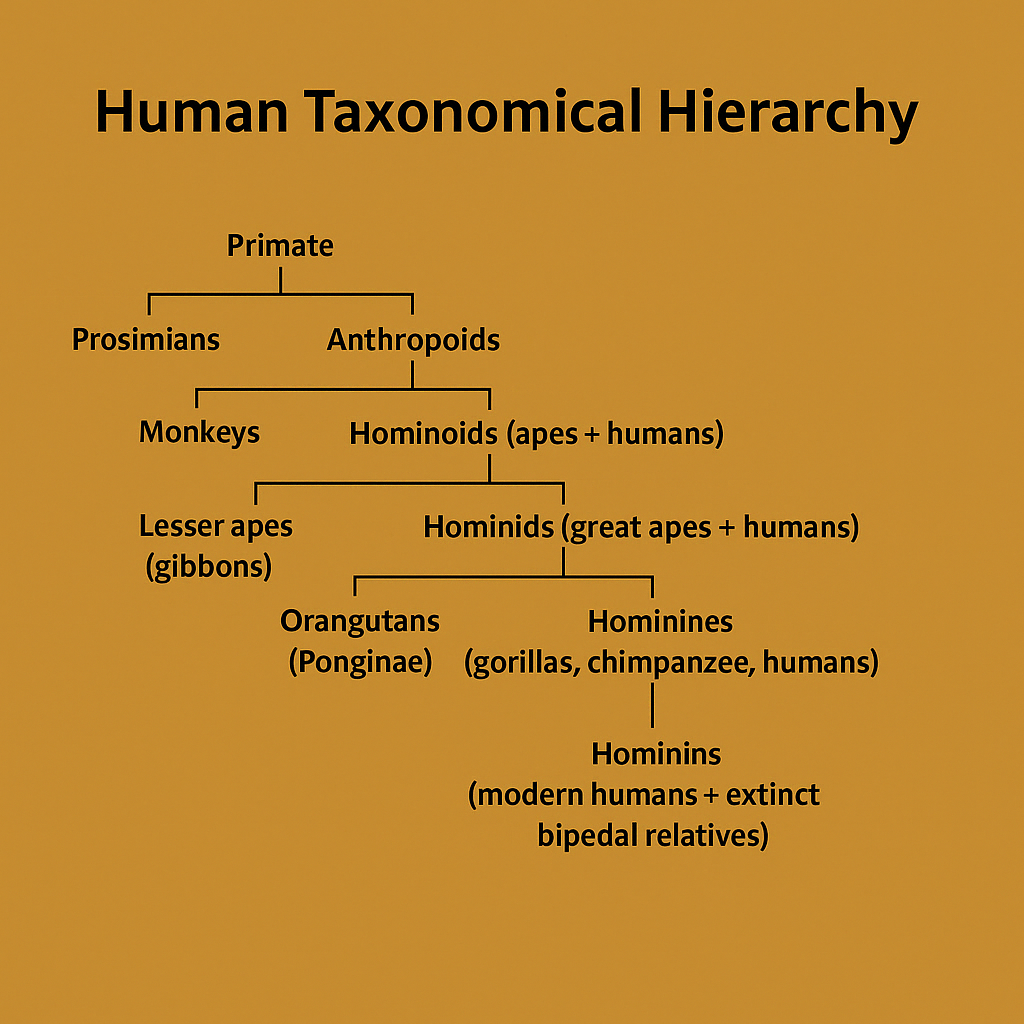
Part 5: Online Resources for Further Exploration
Want to dive deeper into the weird, winding path of human evolution? These links provide access to fossil databases, museum archives, academic overviews, and interactive tools designed for everyone from beginners to serious paleo nerds.
I want to first of all recommend this very interesting video that covers evolution on a very high level and very broadly without getting lost in the weeds of scholarly detail.
Watch this high-level introduction to human evolution (YouTube)
General Overviews and Educational Platforms
- Becoming Human – Institute of Human Origins
- Human Origins Program – Smithsonian
- Understanding Evolution – UCMP
- TalkOrigins Archive
Fossil Databases and Research Tools
DNA and Genetics in Human Evolution
Interactive and Visual Tools
Museum Collections and Exhibits
Scientific Journals and Articles (Open Access)
Bonus: Skepticism, Critical Thinking, and Science Advocacy
Feel free to lose a few hours (or days) down these rabbit holes. Human evolution is a massive, messy, fascinating subject—and this list is just a fossilized toe dipped in the ancient waters.




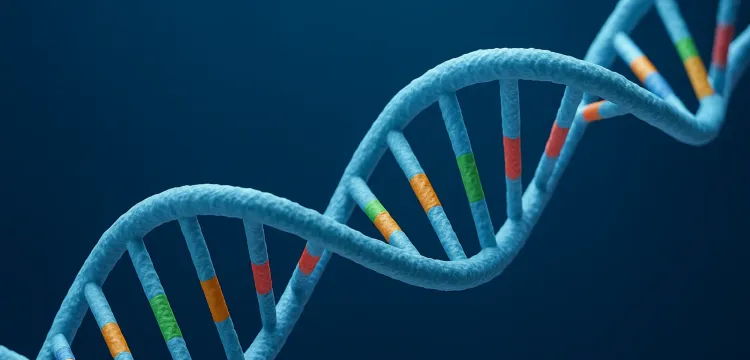
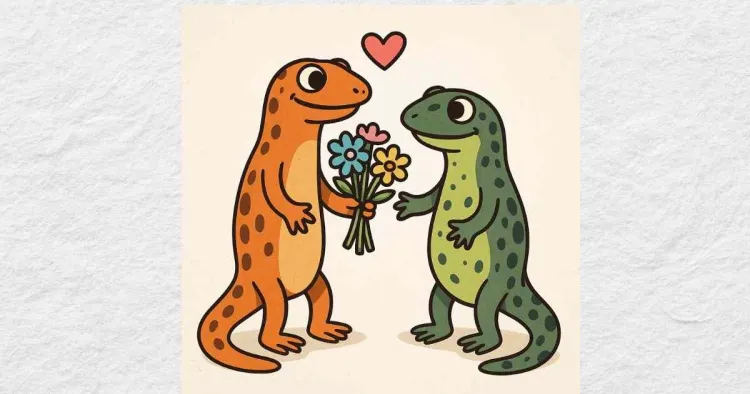
Comments ()